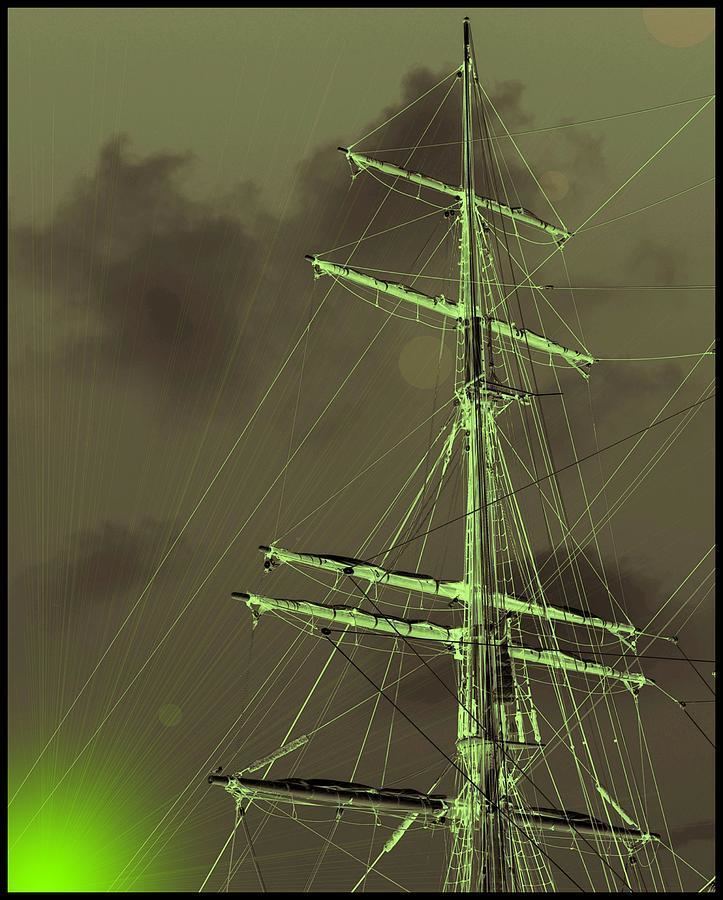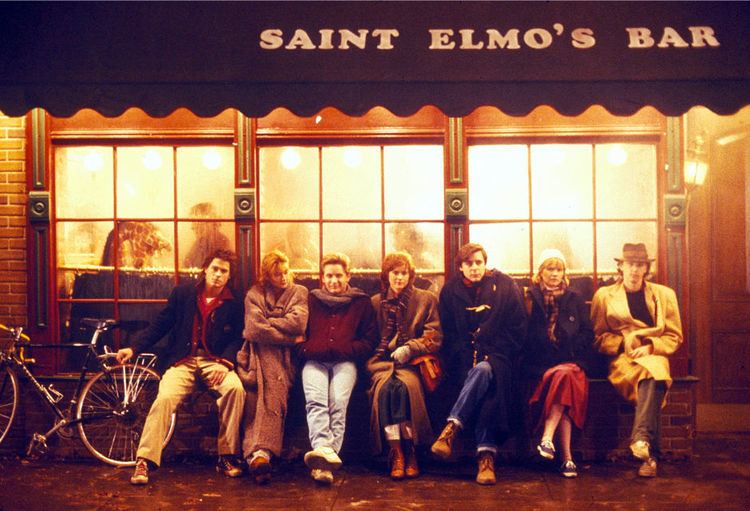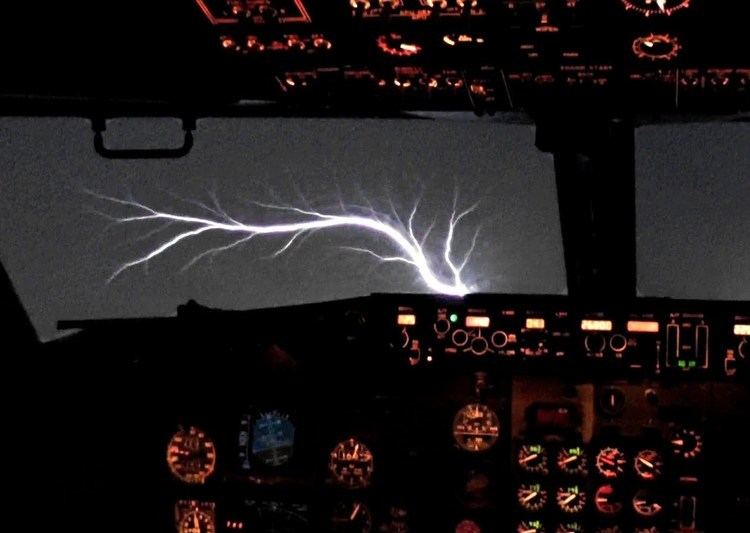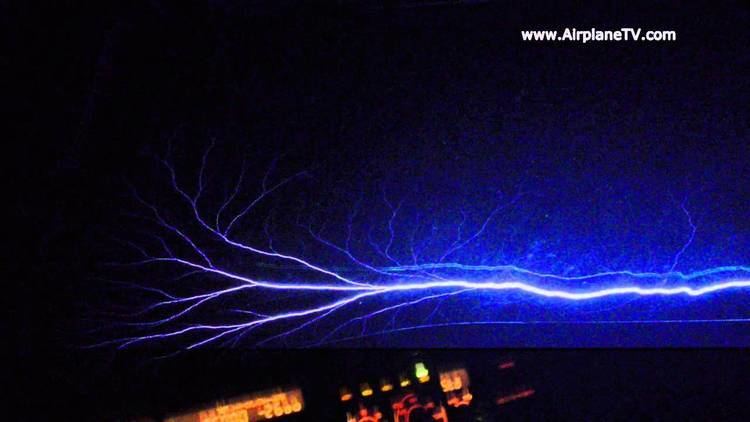 | ||
St elmo s fire man in motion
St. Elmo's fire (also St. Elmo's light) is a weather phenomenon in which luminous plasma is created by a coronal discharge from a sharp or pointed object in a strong electric field in the atmosphere (such as those generated by thunderstorms or created by a volcanic eruption).
Contents
- St elmo s fire man in motion
- 737 jumpseat takeoff st elmo s fire
- Characteristics
- Cause
- Notable observations
- In literature
- In television
- In music
- References

St. Elmo's fire is named after St. Erasmus of Formia (also called St. Elmo, one of the two Italian names for St. Erasmus, the other being St. Erasmo), the patron saint of sailors. The phenomenon sometimes appeared on ships at sea during thunderstorms and was regarded by sailors with religious awe for its glowing ball of light, accounting for the name. Sailors may have considered St. Elmo's fire as a good omen (as a sign of the presence of their patron saint).

737 jumpseat takeoff st elmo s fire
Characteristics

St. Elmo's fire is a bright blue or violet glow, appearing like fire in some circumstances, from tall, sharply pointed structures such as lightning rods, masts, spires and chimneys, and on aircraft wings or nose cones. St. Elmo's fire can also appear on leaves and grass, and even at the tips of cattle horns. Often accompanying the glow is a distinct hissing or buzzing sound. It is sometimes confused with ball lightning.

In 1751, Benjamin Franklin hypothesized that a pointed iron rod would light up at the tip during a lightning storm, similar in appearance to St. Elmo's fire.
Cause

St. Elmo's fire is a form of plasma. The electric field around the object in question causes ionization of the air molecules, producing a faint glow easily visible in low-light conditions. Conditions that can generate St. Elmo's fire are present during thunderstorms, when high voltage differentials are present between clouds and the ground underneath. A local electric field of approximately 100 kV/m is required to induce a discharge in air. The magnitude of the electric field depends greatly on the geometry (shape and size) of the object. Sharp points lower the necessary voltage because electric fields are more concentrated in areas of high curvature, so discharges preferably occur and are more intense at the ends of pointed objects.

The nitrogen and oxygen in the Earth's atmosphere cause St. Elmo's fire to fluoresce with blue or violet light; this is similar to the mechanism that causes neon lights to glow.
Notable observations
In ancient Greece, the appearance of a single one was called helene (Greek: ἑλένη), meaning torch, and two were called Kastor and Polydeuces. Occasionally, it was associated with the Greek element of fire, as well as with one of Paracelsus's elementals, specifically the salamander, or, alternatively, with a similar creature referred to as an acthnici.
Welsh mariners knew it as canwyll yr ysbryd ("spirit-candles") or canwyll yr ysbryd glân ("candles of the Holy Ghost"), or the "candles of St. David".
References to St. Elmo's fire can be found in the works of Julius Caesar (De Bello Africo, 47), Pliny the Elder (Naturalis Historia, book 2, par. 101), Alcaeus frag. 34, and Antonio Pigafetta's journal of his voyage with Ferdinand Magellan. St. Elmo's fire, also known as "corposants" or "corpusants" from the Portuguese corpo santo ("holy body"), was a phenomenon described in The Lusiads.
In 15th-century Ming China, Admiral Zheng He and his associates composed the Liujiagang and Chang-le inscriptions, the two epitaphs of the treasure voyages where they made a reference to St. Elmo's fire as a divine omen of Tianfei, the goddess of sailors and seafarers.
Robert Burton wrote of St. Elmo's fire in his Anatomy of Melancholy: "Radzivilius, the Lithunian duke, calls this apparition Sancti Germani sidus; and saith moreover that he saw the same after in a storm, as he was sailing, 1582, from Alexandria to Rhodes". This refers to the voyage made by Mikołaj Krzysztof "the Orphan" Radziwiłł in 1582–1584.
On 9 May 1605, while on the second voyage of John Davis commanded by Sir Edward Michelborne to the East Indies, an unknown writer aboard the Tiger describes the phenomenon; "In the extremity of our storm appeared to us in the night, upon our maine Top-mast head, a flame about the bigness of a great Candle, which the Portugals call Corpo Sancto, holding it a most divine token that when it appeareth the worst is past. As, thanked be God, we had better weather after it".
William Noah, a silversmith convicted in London of stealing 2,000 pounds of lead, while on route to Sydney, New South Wales on the convict transport ship Hillsborough, recorded two such observations in his detailed daily journal. The first was in the Southern Ocean midway between Cape Town and Sydney and the second was in the Tasman Sea, a day out of Port Jackson:
While the exact nature of these weather phenomenon cannot be certain, they appear to be mostly about two observations of St. Elmo's fire with perhaps some ball lightning and even a direct lightning strike to the ship thrown into the mix.
On 20 February 1817, during a severe electrical storm James Braid, surgeon at Lord Hopetoun's mines at Leadhills, Lanarkshire, had an extraordinary experience whilst on horseback:
Weeks earlier, reportedly on 17 January 1817, a luminous snowstorm occurred in Vermont and New Hampshire. Saint Elmo's fire appeared as static discharges on roof peaks, fence posts, and the hats and fingers of people. Thunderstorms prevailed over central New England.
Charles Darwin noted the effect while aboard the Beagle. He wrote of the episode in a letter to J. S. Henslow that one night when the Beagle was anchored in the estuary of the Río de la Plata:
St. Elmo's fire is reported to have been seen during the Siege of Constantinople by the Ottoman Empire in 1453. It reportedly was seen emitting from the top of the Hippodrome. The Byzantines attributed it to a sign that the Christian God would soon come and destroy the conquering Muslim army. According to George Sphrantzes, it disappeared just days before Constantinople fell, ending the Byzantine Empire.
In Two Years Before the Mast, Richard Henry Dana, Jr. describes seeing a corposant in the Horse latitudes of the northern Atlantic Ocean. However, he may have been talking about ball lightning; as mentioned earlier it is often erroneously identified as St. Elmo's fire: "There, directly over where we had been standing, upon the main top-gallant mast-head, was a ball of light, which the sailors name a corposant (corpus sancti), and which the mate had called out to us to look at. They were all watching it carefully, for sailors have a notion, that if the corposant rises in the rigging, it is a sign of fair weather, but if it comes lower down, there will be a storm".
Many Russian sailors have seen them throughout the years. To them, they are "Saint Nicholas" or "Saint Peter's lights". They were also sometimes called St. Helen's or St. Hermes' fire, perhaps through linguistic confusion.
Nikola Tesla created St. Elmo's Fire in 1899 while testing out a Tesla coil at his laboratory in Colorado Springs, USA. St. Elmo's fire was seen around the coil and was said to have lit up the wings of butterflies with blue halos as they flew around.
Shortly before the crash of the Luftschiffbau Zeppelin's Hindenburg in 1937, Professor Mark Heald of Princeton saw St. Elmo's Fire flickering along the airship's back a minute before the fire broke out. Standing outside the main gate to the Naval Air Station, he watched, together with his wife and son, as the airship approached the mast and dropped her bow lines. A minute thereafter, by Heald's estimation, he first noticed a dim "blue flame" flickering along the backbone girder about one-quarter the length abaft the bow to the tail. There was time for him to remark to his wife, "Oh, heavens, the thing is afire," for her to reply, "Where?" and for him to answer, "Up along the top ridge" – before there was a big burst of flaming hydrogen from a point he estimated to be about one-third the ship's length from the stern.
St. Elmo's fire was reported by New York Times reporter William L. Laurence on August 9, 1945 as he was on the plane with the atomic bomb heading towards Nagasaki.
St Elmo's fire were also seen during the 1955 Great Plains tornado outbreak in Kansas and Oklahoma (US).
Accounts of Magellan's first circumnavigation of the globe refer to St. Elmo's fire being seen around the fleet's ships multiple times off the coast of South America. The sailors saw these as favorable omens.
On 26 August 1883, the British warship Charles Ball sailing the Sunda Strait en route to Hong Kong came within 20 km of the exploding Krakatau volcano and witnessed a great deal of static electricity in the atmosphere, generated by the movement of tiny particles of rocks and droplets of water from the volcano's steam, which caused spectacular brush discharges taking place from the masts and rigging of the ship.
Among the phenomena experienced on British Airways Flight 9 on 24 June 1982 were glowing light flashes along the leading edges of the aircraft, which were seen by both passengers and crew. While it shared similarities with St Elmo's fire, the glow experienced was from the impact of ash particles on the leading edges of the aircraft, similar to that seen by operators of sandblasting equipment.
St. Elmo's fire was observed and its optical spectrum recorded during a University of Alaska research flight over the Amazon in 1995 to study sprites.
The ill-fated Air France Flight 447 flight from Rio de Janeiro–Galeão (GIG) to Paris Charles de Gaulle Airport in 2009 is understood to have experienced St. Elmo's fire 23 minutes prior to crashing into the Atlantic Ocean. However, the phenomenon was not a factor on the disaster.
In literature
One of the earliest references to the phenomenon appears in Alcaeus's Fragment 34a about the Dioscuri, or Castor and Pollux. It is also referenced in Homeric Hymn 33 to the Dioscuri who were from Homeric times associated with it. Whether the Homeric Hymn antedates the Alcaeus fragment is unknown.
St. Elmo's Fire is also mentioned in The Castaways of the Flying Dutchman by Brian Jacques.
The phenomenon appears to be described first in the Gesta Herwardi, written around 1100 and concerning an event of the 1070s. However, one of the earliest direct references to St. Elmo's fire made in fiction can be found in Ludovico Ariosto's epic poem Orlando Furioso (1516). It is located in the 17th canto (19th in the revised edition of 1532) after a storm has punished the ship of Marfisa, Astolfo, Aquilant, Grifon, and others, for three straight days, and is positively associated with hope:
In Shakespeare's The Tempest (c. 1623), Act I, Scene II, St. Elmo's fire acquires a more negative association, appearing as evidence of the tempest inflicted by Ariel according to the command of Prospero:
The fires are also mentioned as "death fires" in Samuel Taylor Coleridge's The Rime of the Ancient Mariner.
Later in 18th century and 19th century literature associated St. Elmo's fire with bad omen or divine judgment, coinciding with the growing conventions of Romanticism and the Gothic novel. For example, in Ann Radcliffe's The Mysteries of Udolpho (1794), during a thunderstorm above the ramparts of the castle:
In Herman Melville's novel Moby-Dick, Starbuck points out "corpusants" during a thunder storm in the Japanese sea in chapter 119 "The Candles".
In Lars von Trier's 2011 film Melancholia, the phenomenon is clearly observed in the opening sequence and later in the film as the rogue planet Melancholia approaches Earth for an impact event.
St. Elmo's fire makes an appearance in The Adventures of Tintin comic, Tintin in Tibet, by Hergé. Tintin recognizes the phenomenon on Captain Haddock's ice-axe.
In Kurt Vonnegut's Slaughterhouse-Five, Billy Pilgrim sees the phenomenon on soldiers' helmets and on rooftops. Vonnegut's The Sirens of Titan also notes the phenomenon affecting Winston Niles Rumfoord's dog, Kazak, the Hound of Space, in conjunction with solar disturbances of the chrono-synclastic infundibulum.
In "On The Banks of Plum Creek" by Laura Ingalls Wilder St. Elmo's fire is seen by the girls and Ma during one of the blizzards. It was described as coming down the stove pipe and rolling across the floor following Ma's knitting needles; it didn't burn the floor (pages 309-310). The phenomenon as described, however, is more similar to ball lightning.
In television
On the children's television series The Mysterious Cities of Gold (1982), Episode 4 shows St. Elmo's Fire affecting the ship as it sailed past the Strait of Magellan. The real-life footage at the end of the episode has snippets of an interview with Japanese sailor Fukunari Imada, whose comments were translated to "Although I've never seen St. Elmo's Fire, I'd certainly like to. It was often considered a bad omen as it played havoc with compasses and equipment". The TV series also referred to St. Elmo's Fire as being a bad omen during the cartoon. The footage was captured as part of his winning solo yacht race in 1981.
In an episode of the television series "Bonanza," religious pilgrims residing on the Cartwright property interpret an encounter with St. Elmo's Fire as demonic activity. This depiction adds to the diverse cultural representations and interpretations of St. Elmo's Fire in media.
In music
Brian Eno's third studio album Another Green World (1975) contains a song titled "St. Elmo's Fire" in which guesting King Crimson guitarist Robert Fripp (credited with playing "Wimshurst guitar" in the liner notes) improvises a lightning-fast solo that would imitate an electrical charge between two poles on a Wimshurst high voltage generator.
Michael Frank's song "St Elmo's Fire" was released on his album "The Art of Tea" in 1976. His song has since been sampled various times by artists like Absolutely Fabolous, & more.
The first song in Susumu Hirasawa's album Aurora, "Stone Garden" (石の庭 Ishi no Niwa), contains a line which translates to
"St. Elmo's Fire (Man in Motion)" is a song recorded by John Parr. It hit number one on the Billboard Hot 100 on September 7, 1985, remaining there for two weeks. It was the main theme for Joel Schumacher's 1985 film St. Elmo's Fire (film).
